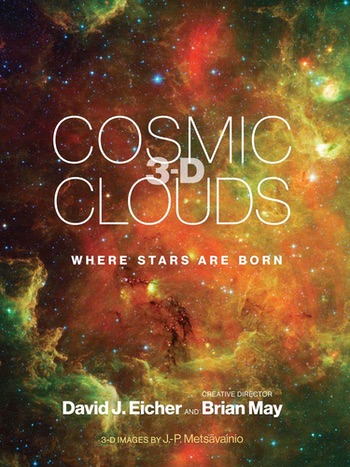Review: Cosmic Clouds 3-Dby Jeff Foust
|
| The final 3-D image is “an appraised simulation of reality based on known scientific facts, deduction, and some artistic creativity on top of everything else.” |
Stereoscopic imagery is one of May’s interests, and he reestablished a Victorian-era company, the London Stereoscopic Company (LSC), to pursue it. Those interests are on display in the new book Cosmic Clouds 3-D, for which May is the “creative director.” What responsibilities that role has aren’t exactly clear, but it appears to involve the general direction of the book, written by David Eicher and using images taken and processed by Finnish astronomer J.-P. Metsävainio.
Regardless of their individual responsibilities, the three have created a visually appealing book on the subject of nebulae, the “cosmic clouds” of the book’s title. It’s easy to see why they chose this particular topic: nebulae are colorful objects with intricate structures, lending themselves to astrophotography and three-dimensional imaging. The book includes dozens of stereoscopic images, along with a viewer from May’s LSC to see them. (You can get the 3-D effect with the viewer if you’re adept at the “cross-eye” method of viewing such images, although the viewer works better.)
The book includes many other non-stereoscopic images of galaxies, with explanations about the various nebula classes and our understanding of them. However, the stereoscopic images are the star of the book. The structure of the gas and dust clouds is striking in those images, and the stereo views help the reader better understand what these objects are.
But, as noted above, it took images from a spacecraft seven billion kilometers away to get a nearby star to shift ever so slightly. How, then, can you create stereoscopic images of distant nebulae? In a brief appendix, Metsävainio, the astrophotographer, discusses his technique. While he says he uses “scientific information” to make accurate representations, it’s also art to some degree. The final 3-D image he produces on his computer, he writes, is “an appraised simulation of reality based on known scientific facts, deduction, and some artistic creativity on top of everything else.”
So, the images you see in Cosmic Clouds 3-D aren’t pure science, although one can argue the same is true for any astronomical image that is processed and colorized in various ways. Still, they help add a third dimension to nebulae and allow the reader to better understand what they are, and appreciate their beauty. Given the challenges of making true stereoscopic images of astronomical objects, as demonstrated by the New Horizons experiment, this may be close to the best we can do for the indefinite future.
Note: we are temporarily moderating all comments submitted to deal with a surge in spam.
